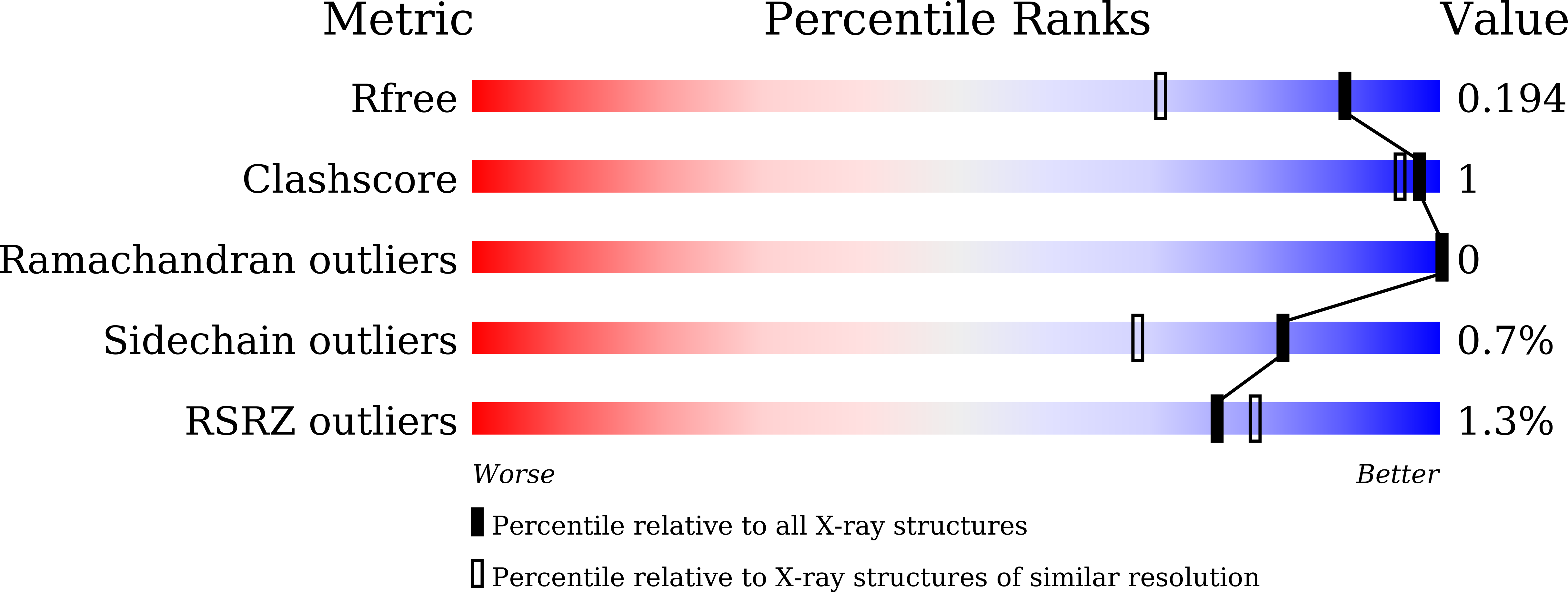Assessing the Potency of beta-Lactamase Inhibitors with Diverse Inactivation Mechanisms against the PenA1 Carbapenemase from Burkholderia multivorans .
Nukaga, M., Yoon, M.J., Taracilia, M.A., Hoshino, T., Becka, S.A., Zeiser, E.T., Johnson, J.R., Papp-Wallace, K.M.(2021) ACS Infect Dis 7: 826-837
- PubMed: 33723985
- DOI: https://doi.org/10.1021/acsinfecdis.0c00682
- Primary Citation of Related Structures:
7D5J - PubMed Abstract:
Burkholderia cepacia complex (Bcc) poses a serious health threat to people with cystic fibrosis or compromised immune systems. Infections often arise from Bcc strains, which are highly resistant to many classes of antibiotics, including β-lactams. β-Lactam resistance in Bcc is conferred largely via PenA-like β-lactamases. Avibactam was previously shown to be a potent inactivator of PenA1. Here, we examined the inactivation mechanism of PenA1, a class A serine carbapenemase from Burkholderia multivorans using β-lactamase inhibitors (β-lactam-, diazabicyclooctane-, and boronate-based) with diverse mechanisms of action. In whole cell based assays, avibactam, relebactam, enmetazobactam, and vaborbactam restored susceptibility to piperacillin against PenA1 expressed in Escherichia coli . The rank order of potency of inactivation in vitro based on k inact / K I or k 2 / K values (range: 3.4 × 10 2 to 2 × 10 6 M -1 s -1 ) against PenA1 was avibactam > enmetazobactam > tazobactam > relebactam > clavulanic acid > vaborbactam. The contribution of selected amino acids (S70, K73, S130, E166, N170, R220, K234, T237, and D276) in PenA1 toward inactivation was evaluated using site-directed mutagenesis. The S130A, R220A, and K234A variants of PenA1 were less susceptible to inactivation by avibactam. The R220A variant was purified and assessed via steady-state inhibition kinetics and found to possess increased K i-app values and decreased k inact / K I or k 2 / K values against all tested inhibitors compared to PenA1. Avibactam was the most affected by the alanine replacement at 220 with a nearly 400-fold decreased acylation rate. The X-ray crystal structure of the R220A variant was solved and revealed loss of the hydrogen bonding network between residues 237 and 276 leaving a void in the active site that was occupied instead by water molecules. Michaelis-Menten complexes were generated to elucidate the molecular contributions of the poorer in vitro inhibition profile of vaborbactam against PenA1 ( k 2 / K , 3.4 × 10 2 M -1 s -1 ) and was compared to KPC-2, a class A carbapenemase that is robustly inhibited by vaborbactam. The active site of PenA1 is larger than that of KPC-2, which impacted the ability of vaborbactam to form favorable interactions, and as a result the carboxylate of vaborbactam was drawn toward K234/T235 in PenA1 displacing the boronic acid from approaching the nucleophilic S70. Moreover, in PenA1, the tyrosine at position 105 compared to tryptophan in KPC-2, was more flexible rotating more than 90°, and as a result PenA1's Y105 competed for binding with the cyclic boronate vs the thiophene moiety of vaborbactam, further precluding inhibition of PenA1 by vaborbactam. Given the 400-fold decreased k 2 / K for the R220A variant compared to PenA1, acyl-enzyme complexes were generated via molecular modeling and compared to the PenA1-avibactam crystal structure. The water molecules occupying the active site of the R220A variant are unable to stabilize the T237 and D276 region of the active site altering the ability of avibactam to form favorable interactions compared to PenA1. The former likely impacts the ability of all inhibitors to effectively acylate this variant enzyme. Based on the summation of all evidence herein, the utility of these newer β-lactamase inhibitors ( i.e. , relebactam, enmetazobactam, avibactam, and vaborbactam) in combination with a β-lactam against B . multivorans producing PenA1 and the R220A variant is promising.
Organizational Affiliation:
Department of Pharmaceutical Sciences, Josai International University, Togane City, Chiba 283-8555, Japan.















